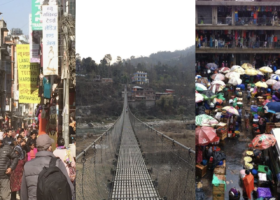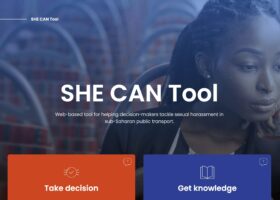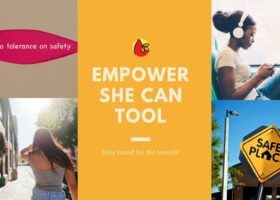
Overview
Background and objective:
Key motivations for the study described in this paper were to gain insights into the differences in travel behaviour between males and females, as well as gender-based sexual harassment exposure in public transport in sub-Saharan Africa. The mobility and sexual harassment results, based on data collection in two African cities (Blantyre in Malawi and Lagos in Nigeria), is presented in this paper, to document the true extent of sexual harassment and ways in which sexual harassment practices affected women’s mobility on the continent. The analysis aims to illuminate gender-based mobility differences and sexual harassment experiences, as well as provide some guiding principles towards addressing sexual harassment challenges.
Method: and Data:
This study developed a standardised gender-based travel and sexual harassment perception questionnaire that was applied via pen-and-paper, as well as technology (offline tablets) in the cities of Lagos (Nigeria) and Blantyre (Malawi). Overall, 1478 respondents participated. Approximately 58% of the sample in both cities were women. The data collected was analysed to highlight differences between male and female travel behaviour and differences in relation to exposure to sexual harassment whilst in the transport system.
Results:
Data revealed that women make more, shorter trips, while they carry a significantly higher sexual harassment burden. All parts of public transport trips are affected, including travelling to/ from the system, while waiting for the vehicle and in the vehicle. The need for transfers increases the risk of crime and sexual harassment. This paper concludes that there is a need for improved policy frameworks, educational campaigns, for men and women, as well as the creation of safe reporting structures when sexual harassment does occur. Actions are needed in the two case study cities and beyond.
Publications with the same themes
Publications with the same study countries
Related news & events
News
PDF content (text-only)
Social Sciences & Humanities Open 7 (2023) 100442
Contents lists available at ScienceDirect
Social Sciences & Humanities Open
ELSEVIER journal homepage: www.sciencedirect.com/journallsocial-sciences-and-humanities-open
Regular Article
Lessons learnt through gender-based travel data collection and related
sexual harassment in Sub-Saharan Africa
Marianne Vanderschuren a,*, Heather Allen b, Philip Krause c, Tanya Lane-Visser a
a Centre for Transport Srudies, University of Cape Town. 1 Madiba Circle, Upper Campus, Rondebosch, 7701, South Africa
b Independent Gender & Srntainable Transport Consultant., Median SCL, Rue du Moulin d'hoUers B, 1495, Villers la Ville, Belgium
c GoAscendal. 54 Oxford St., DurbanviUe, Cape Town, 7550, South Africa
ARTICLE INFO
Keywords:
Gender
Personal safety
Sexual harassment
Public transport
Africa
1. Introduction
ABSTRACT
Background and objective: Key motivations for the study described in this paper were to gain insights into the
differences in travel behaviour between males and females, as well as gender-based sexual harassment exposure
in public transport in sub-Saharan Africa. The mobility and sexual harassment results, based on data collection in
two African cities (Blantyre in Malawi and Lagos in Nigeria), is presented in this paper, to document the true
extent of sexual harassment and ways in which sexual harassment practices affected women's mobility on the
continent. The analysis aims to illuminate gender-based mobility differences and sexual harassment experiences,
as well as provide some guiding principles towards addressing sexual harassment challenges.
Method: and Data: This study developed a standardised gender-based travel and sexual harassment perception
questionnaire that was applied via pen-and-paper, as well as technology (offline tablets) in the cities of Lagos
(Nigeria) and Blantyre (Malawi). Overall, 1478 respondents participated. Approximately 58% of the sample in
both cities were women. The data collected was analysed to highlight differences between male and female travel
behaviour and differences in relation to exposure to sexual harassment whilst in the transport system.
Results: Data revealed that women make more, shorter trips, while they carry a significantly higher sexual
harassment burden. All parts of public transport trips are affected, including travelling to/ from the system, while
waiting for the vehicle and in the vehicle. The need for transfers increases the risk of crime and sexual
harassment. This paper concludes that there is a need for improved policy frameworks, educational campaigns,
for men and women, as well as the creation of safe reporting structures when sexual harassment does occur.
Actions are needed in the two case study cities and beyond.
Since the early 2000s, the topic of 'genderl-based development' has
gathered momentum. Many of the Sustainable Development Goals look
to embed gender equity and female empowerment into the International
Agenda 2030. UNDP's Human Development Report (1 995) highlighted
that 70% of the 1.2 billion people living in poverty worldwide are
women. This figure has remained stubbornly high ever since (Azcona
et aI., 2020). In practice, the sheer pace and volume of urbanisation
compounds the under representation and difficulties of addressing
gender issues. This is especially pronounced in Africa, where almost 900
million new urban dwellers are expected by 2030 Chttps://www.moib
rahimfoundation.org). Today, half of Africa's urban dwellers live in
precarious conditions in informal settlements. Some 75% of new urban
inhabitants are younger than 35 years old, with a high share of them
being female Chttps://www.citiesalliance.org).
Across the world, women face real and perceived threats of genderbased
violence, assault, and harassment, while negotiating their daily
travel in public spaces. In developing countries, limited access to, and
the safety of, transport is estimated to reduce female labour force
participation by 16.5% (SuM4All, 2019). This paper focuses on the individuals'
perception of their own security, which is defined as their
* Corresponding author.
E-mail address: marianne.vanderschuren@uct.ac.za (M. Vanderschuren).
1 Sex is the biological classification of males and females, determined at birth, while gender is a culturally defined set of economic, social, and political roles,
responsibilities, rights, entitlements, and obligations associated with being female, male and LGBTQIA+ . In this paper the term gender is used interchangeably with
women.
https://doi.org/10.1016/j.ssaho.2023.100442
Received 27 June 2022; Accepted 7 February 2023
Available online 9 February 2023
2590-291l/© 2023 The Authors. Published by Elsevier Ltd. This is an open access article under the CC BY-NC-ND license (http://creativecommons.org/licenses!bync-
nd/ 4.0/).
M. Vanderschuren et aL
perception of risk or threat from an intentional personal act, attack, or
aggression.
Women living in informal settlements primarily rely on public
transport for their daily travel needs. Besides common concerns related
to the use of (informal) public transport, such as affordability and road
safety, women have the added concerns related to personal security
(Jackson et aI., 2013; Vanderschuren et aI., 2019).
Sexual harassment of women in public space is widespread. A largescale
survey of street harassment, in 42 cities in 2015, based on a sample
of 16 600 female respondents spread across the world, revealed that
approximately 84% had experienced street harassment for the first time
before they were 17 years old (Hollaback! and The ILR School, 2015).
Allen et al. (2018), who interviewed female and male public transport
users in Santiago (Chile), Buenos Aires (Argentina) and Quito
(Ecuador), found both sexes pointed to personal safety as a major
concern, but women (between 61 % and 73%) were more worried about
personal safety while using public transport than men (between 58%
and 59%). Orozco-Fontalyo et a1. (2019) found similar results (more
than 60%) regarding the exposure to sexual harassment related to the
use of Bus Rapid Transit (BRT) use in the city of Barranquilla.
Feelings of insecurity were even higher for mothers with children
under 15 years old (78%). Some 60% of the women who claim to have
felt insecure were between 18 and 40 years old. Furthermore, nearly
90% of women in Buenos Aires had experienced some level of sexual
harassment, at least once while using public transport in the previous 12
months. The study found that 36% of those who felt higher levels of
insecurity belong to households with the lowest level of income (less
than approximately US$85 per month), compared to 14% of women
who live in households with the highest income in the sample (more
than approximately US$190 per month), confirming that the sense of
insecurity decreases as income increases.
In India, 91 % of women felt that public transport was very unsafe,
unsafe, or somewhat unsafe (Shah & Raman, 2019). In Loukaitou and
Ceccato's recent book (2020), the Lagos (Nigeria) case study found that
female college students were 2.2 times more likely to experience
non-verbal sexual violence than males. Only 5% of students reported
always feeling safe walking to or waiting at the bus, keke napep
(tricycle), or motorcycle taxi stops after dark. About a third (31 %) of the
students had never felt safe walking to the transport stops at night, and
about one-fifth (21%) rarely felt safe (Loukaitou-Sideris & Ceccato,
2020). Capasso da Silva and Rodrigues da Silva (2020) established that
over 20% of the respondents from a Brazilian University campus have
been victims of violence on their trips to or from the campus. Concerns
over personal security perception can lead to trip avoidance (Jeong
et al., 2017; Piscitelli & Perrella, 2017) or a change in mode choice
(Delbosc & Currie, 2012; Verma et aI., 2017).
Fears about female personal safety and security are well documented
in both the global north and south, but there is little evidence from subSaharan
African cities currently available in the literature. In Africa,
transport data is generally poor, resulting in disaggregated information
on urban transport, which is rarely robust or widely available (Gwilliam,
2013).
2. Research Aim
Key motivations for the study described in this paper were to gain
insights into the differences in travel behaviour between males and females,
as well as gender-based sexual harassment exposure in public
transport in sub-Saharan Africa. The work included the development of
a survey instrument for data collection, as well as a methodology which
can be replicated in other cities of Africa, and beyond.
This paper sets out to provide insight into travel behaviour differences
between men and women, and their exposure to gender-based
sexual harassment, based on data collection in the two above
mentioned African cities, to document the true extent of sexual harassment,
and ways in which sexual harassment practices affect women's
2
Social Sciences & Humanities Open 7 (2023) 100442
mobility on the continent. The analysis aims to illuminate gender-based
mobility differences and sexual harassment experiences, as well as
provide some guiding principles towards addressing gender-based
mobility and sexual harassment challenges.
The research approach and the findings are being used as part of a
wider project, that develops a user-friendly online decision-support tool
for urban transport planners and related stakeholders, with a focus on
addressing sexual harassment in public transport in Africa.
3. Data Collection methodology
This study focussed on collecting data from urban public transport
users and key stakeholders in two African cities with distinctly different
transport profiles - Lagos (Nigeria) and Blantyre (Malawi). Lagos is a
large mega city (over 10 million inhabitants) with a wide variety of
public transport modes, including formal (Bus Rapid Transit and ferries)
and informal (minibus taxis, motorcycle and cycle taxis) modes; Blantyre
has just over 1 million inhabitants and the modes available are
predominantly minibus taxis and sedan taxis (no formal public transport
services are available).
Data was collected in both cities using the same questionnaires,
slightly adapted for the local context. Both technology- (offline tablets)
and paper-based survey collection methods were used to randomly
intercept people at main transport hubs, while the survey findings were
validated in focus groups in each city. Interestingly, the response rates
were influenced by the data collection method, where digital collection
rendered better response rates.
Before data collection commenced, ethics clearance was obtained via
the University of Cape Town. This was explained to questionnaire and
focus group participants. The consent description that was shared with
participants first, elaborated on the fact that participation was voluntary
and that opting out was possible at any time. Participants provided
consent in the very first questions answered.
In Blantyre, 686 respondents participated in the survey while the
response rate in Lagos was 792 participants. The data was collected in
the period between 5 March and March 12, 2021, between 9h30 and
18hOO daily. For both cities, the response rate falls comfortably within
the 95% reliability sample size margin. For Blantyre, based on a statistical
Confidence Interval (CI) calculation, there is a 96.26% certainty
that the sample is representative for the inhabitants in the city. In Lagos,
the statistical reliability that sample participants represent the urban
population in the city is even higher with 96.52% reliability. By design,
in both cities, more females were targeted and, therefore, participated in
the survey. In Blantyre 58.1 % of respondents were female, while this
was 57.9% in Lagos. Nonetheless the total numbers of respondents
(male/female) fall within one standard deviation, representing a lack of
bias.
Although the sample size of respondents in both cities is considered
high, in Blantyre, there was answer fatigue towards the latter part of the
questionnaire, which affects the sample size for some analysis conducted.
The useable sample size is indicated throughout the analysis in
this paper.
A T-test comparison between the sample groups was carried out.
Where statistically significant differences were found, this is indicated in
the paper.
4. Respondent profiles
Most respondents in Blantyre (55%) and Lagos (56%) were between
the ages of 26-46 years. The second largest respondent age category was
19- 25 years (28% of respondents in Blantyre and 30% in Lagos - see
Fig. 1).
In Lagos, the average age for males and females was approximately
28 years, while the Blantyre females were on average 27 years old, and
males a little older (average 30 years old). These averages are calculated,
assuming a normally distributed sample. Surveyors also documented
M. Vanderschuren et aL
lagos, male
lagos, female
Blantyre, male
Blantyre, female
20% 40% 60% SOo. 100%
. 19·25 years _ 26·46 yea rs .46·55 yea rs . 56 years and over
Fig. 1. Age Distribution of Respondents (Blantyre n = 686; Lagos n = 792).
those who refused to participate in the survey and found that more
women than men were interested in participating once they had been
made aware of the subject matter. Furthermore, more males tended to
omit answering some questions, affecting the response rates of individual
questions presented in this paper.
Respondents in Lagos have a particularly high education level. Over
80% attended college or university, while this was only the case for 35%
of Blantyre's respondents. The high education level in Lagos was expected.
Based on previous surveys in or around the BRT system in Lagos,
as verbally indicated by the Lagos Metropolitan Area Transport Authority
(LAMATA), responses were in line with the typical passenger
profile of the BRT. The percentage males with college or university level
education in Lagos was higher than for females (see Fig. 2). These high
average education levels indicate that the BRT was used mainly for
commuter trips when the surveys were done.
Blantyre respondents overall had a lower college/ university education
rate than in Lagos. However, the sample showed that there is a
noteworthy higher proportion of male college/ university graduates
(42%) than females (29%) in Blantyre. Overall (see Fig. 2), between 71 %
(female) and 81% (male) of respondents in Blantyre have at least
completed high school, while the proportion of female high school only
graduates (41%) is higher than males (39%). In Lagos, the average ed·
ucation level is substantially higher, i.e., between 98% (females) and
99% (males) of respondents have completed at least high school leveL
Most respondents were employed, business owners or self-employed.
In both Lagos and Blantyre, male respondents occupy more fonnal
employment posts than female respondents. The occupation category in
Lagos with the largest share was found to be 'fonnal employment',
especially for males (49% vs. 42%). In Blantyre, the occupation category
with the largest share was found to be 'self-employed', with 49% of
females selecting this category. Remarkably, a substantially lower proportion
(33%) of males selected this category. This may be caused by the
inaccessibility of fonnal jobs by females, while the education levels may
also play a role. Students comprised a slightly higher proportion of
survey respondents in Blantyre than in Lagos: males (13% vs. 11%) and
females (19% vs. 17%) respectively (see Fig. 3). Regarding those who
answered 'other' as their occupation, the most cited occupation for
lagos, male 15% 1
Lagos, female 17% 2
Blantyre, male •••••••• I:==::i39E%;:===='~9~%=]
Blantyre, female 41% 29%
20% 60% 80% 100%
_ Yes, College/University • Yes, Secondary/High school • Less than high school
Fig. 2. Education Level of Respondents (Blantyre n = 686; Lagos n = 790).
3
Social Sciences & Hwnanicies Open 7 (2023) 100442
Lagos, male
Lagos, female
Blantyre, male
Blantyre, female
_ Employed _ Business owner _ Self·employed _ Student _ Other
Fig. 3. Employment Profiles of Respondents (Blantyre n = 315; Lagos n = 792).
women was 'homemaker', 'housewife' or 'staying at home', while men
indicated that they were ' looking for work' or 'doing nothing'. It is
noteworthy that Blantyre had a high number of respondents not willing
to answer this question. The two cities, thus, vary greatly in terms of
average education level and employment status of commuters and,
consequently, in tenns of gender equality.
5. Trip profiles
Most respondents in both cities indicated that they were making a
typical trip at the time they were surveyed (64% of trips in Blantyre and
65% in Lagos). In both case study cities, more men were undertaking
typical trips than the female respondents. In Blantyre, 68% of men and
61 % of women were undertaking typical trips. In Lagos, 63% of women
were undertaking typical trips, slightly more often than their counterparts
in Blantyre, while it was the same for men (68%) in both cities.
This is in line with the occupation statuses; as more men in our sample
have regular employment it is, therefore, more likely that they will be
making more typical (often commuter) trips (see Fig. 4).
In Lagos, typical trips were mainly for work (62%). This is to be
expected based on the high education levels and employment profiles in
Lagos. There are notable differences between males and females
regarding typical work trips, however. Some 68% of trips by males were
work related, while this was only 58% for females. Shopping trips in
Lagos were profoundly higher amongst females, 15% of typical trips,
verses 5% for men. Males in Lagos made more social trips (11%) than
their female (8%) counterparts (see Fig. 5).
Looking at Blantyre, 29% of typical trips by men were to work, while
for women, just 10% of typical trips were to work. The highest proportion
of trip purposes in Blantyre was reported to be shopping (26%).
Compared to Lagos, the proportion of shopping trips for males (30%)
was much higher than that for females (23%). Conversely, in Blantyre
females made more social trips (15% vs. 9% for their male counterparts),
while 'other' trip purposes were a major portion of trips, i.e., 33% of
Lagos, male
lagos, female
Blantyre, male
Blantyre, female
"'" 40% 80% l(X'"
• Tvpiul _ Non·typiGilI
Fig. 4. Typical Trip Profile (Blantyre n = 685; Lagos n = 786).
M. Vanderschuren et aL
8CM 100%
. Wor\:
• EduU'ion
.$/loppinS
• Social
• H"alth vi";. for 5Omei>ody "I""
• H .. alth ,,;'





